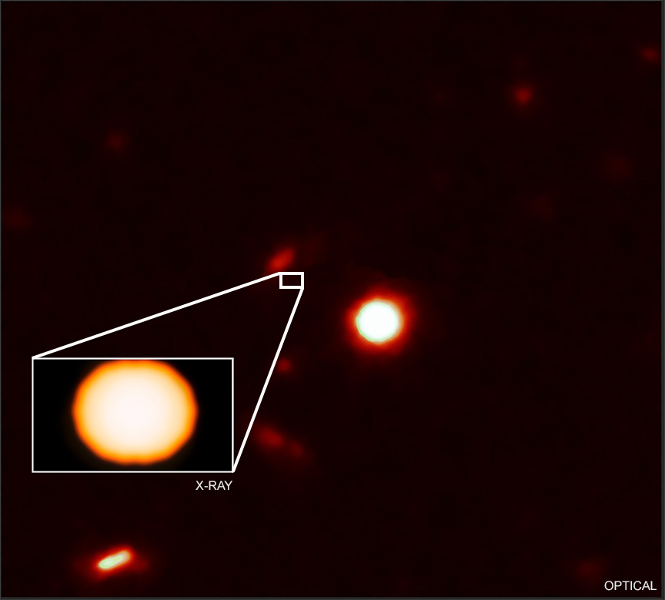
 Credit: X-ray: NASA/CXC/Uni. of Science and Technology of China/Y. Xue et al; Optical: NASA/STScI
Credit: X-ray: NASA/CXC/Uni. of Science and Technology of China/Y. Xue et al; Optical: NASA/STScI
A New Take on Mergers
A neutron star is an incredibly dense objects produced by the supernova explosion of a massive star at the end of its life. Sometimes two neutron stars form a binary system. Presumably these binary neutron stars are descendants of binary systems consisting of two normal, massive stars, and somehow the supernova explosion of each star in the system does not rip the binary apart. We don't really know how often this happens or how many neutron star binary systems there are in our Galaxy. If either of the neutron stars in the binary is a pulsar, orbital motion might be detected from a periodic change in the frequency of the pulse of radio or X-ray radiation emitted by the pulsar due to its orbital motion. Neutron star binaries can be revealed by the gravitational waves produced in spacetime by acceleration of the neutron stars in the binary, similar to the way two boats circling each other produce waves on a lake. Gravitational wave telescopes like LIGO and VIRGO have already detected the strong, variable gravitational waves from one, and perhaps two neutron star binaries during their death inspiral and collision. The collision of a neutron star with another is one of the most powerful events we know of, and should produce powerful radiation. And in fact, a burst of powerful gamma rays was detected from the first neutron star binary merger ever seen, GW 170817. Theories suggest that the gamma rays should be emitted in a narrow beam, and if the beam is not directed at us, we might not see the gamma-ray emission. But neutron star collisions should also produce X-ray emission which is more spread out. A new analysis of data taken the Chandra X-ray Observatory revealed an unusual X-ray transient which appeared suddenly before fading away, with no detectable optical counterpart. The small box in the optical image above shows the location where the X-ray source appeared in an apparently blank region of space. The X-ray source near peak X-ray brightness is shown in the inset. The manner in which this source brightened and faded in X-rays, the types of X-rays the source produced, and its apparent association with a distant galaxy, tell astronomers that this transient X-ray event was probably produced by the merger of two neutron stars in a binary. Scientists believe this titanic merger produced an even more massive, highly magnetized neutron star called a magnetar. Observations like this provide a new way to identify neutron star mergers and help scientists understand how magnetars may be formed.
Published: May 6, 2019
<
HEA Dictionary ● Archive
● Search HEAPOW
● Other Languages
● HEAPOW on Facebook
● Download all Images
● Education ● HEAD
>

Each week the HEASARC
brings you new, exciting and beautiful images from X-ray and Gamma ray
astronomy. Check back each week and be sure to check out the HEAPOW archive!
Page Author: Dr. Michael F. Corcoran
Last modified Tuesday, 27-Feb-2024 10:15:20 EST


